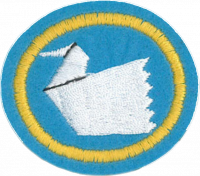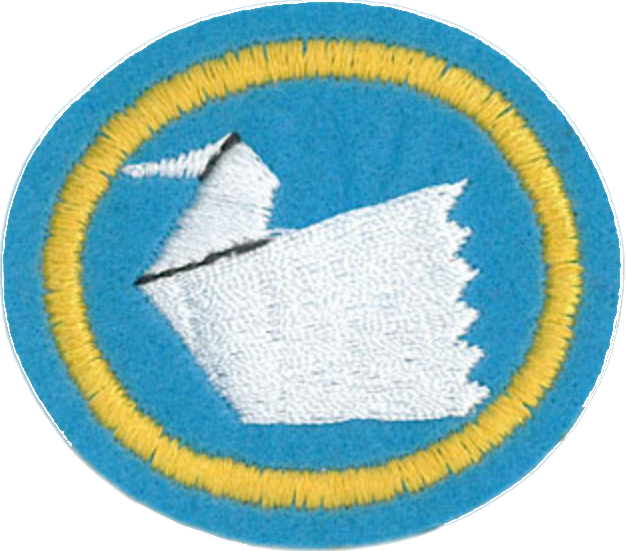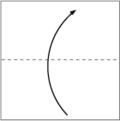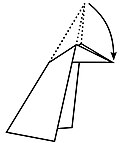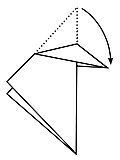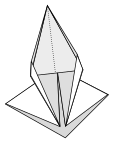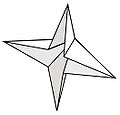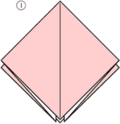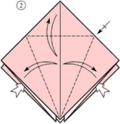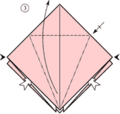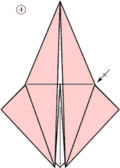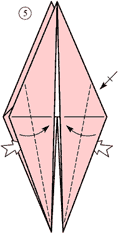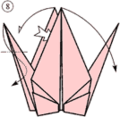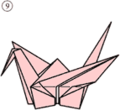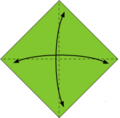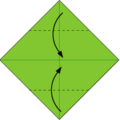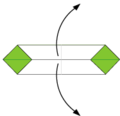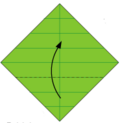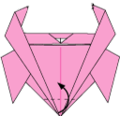Difference between revisions of "AY Honors/Origami/Answer Key"
m (- Category of AYHAB) |
|||
| (37 intermediate revisions by 8 users not shown) | |||
| Line 1: | Line 1: | ||
| − | {{ | + | {{HonorSubpage}} |
| + | <section begin="Body" /> | ||
| + | {{ansreq|page={{#titleparts:{{PAGENAME}}|2|1}}|num=1}} | ||
| + | <noinclude><translate><!--T:60--> | ||
| + | </noinclude> | ||
| + | <!-- 1. What is Origami? Where did it come from? How was it used and developed? --> | ||
| − | + | ===What is Origami?=== <!--T:4--> | |
| − | ===What is Origami?=== | + | Origami (derived from "ori" meaning "to fold", and "kami", meaning paper, and changed to voiced sound "gami") is the ancient Japanese art of paper folding. The goal of this art is to create a given result using geometric folds and crease patterns preferably without the use of gluing or cutting the paper medium. "Origami" refers to all types of paper folding, even those of non-Asian origin. |
| − | |||
| − | ===Where did it come from?=== | + | ===Where did it come from?=== <!--T:5--> |
| + | Distinct paperfolding traditions arose in Europe, China, and Japan which have been well-documented by historians. These seem to have been mostly separate traditions, until the 20th century. | ||
| − | ===How was it used and developed?=== | + | ===How was it used and developed?=== <!--T:6--> |
| + | In Japan, the earliest unambiguous reference to a paper model is in a short poem by Ihara Saikaku in 1680 which mentions a traditional butterfly design used during Shinto weddings. In China, traditional funerals often include the burning of folded paper, most often representations of gold nuggets (yuanbao). The practice of burning paper representations instead of full-scale wood or clay replicas dates from the Sung Dynasty, though it's not clear how much folding was involved. Traditional Chinese funeral practices were banned during the Cultural Revolution, so most of what we know about Chinese paperfolding comes from the modern-day continuation of these practices in Taiwan. In Europe, there was a well-developed genre of napkin-folding, which flourished during the 17th and 18th centuries. After this period, this genre declined and was mostly forgotten; historian Joan Sallas attributes this to the introduction of porcelain, which replaced complex napkin folds as a dinner-table status symbol among nobility. However, some of the techniques and bases associated with this tradition continued to be a part of European culture; folding was a significant part of Friedrich Froebel's "Kindergarten" method, and the designs published in connection with his curriculum are stylistically similar to the napkin fold repertoire. | ||
| − | ==2. Identify the symbols for the following terms: | + | <!--T:61--> |
| + | <noinclude></translate></noinclude> | ||
| + | {{CloseReq}} <!-- 1 --> | ||
| + | {{ansreq|page={{#titleparts:{{PAGENAME}}|2|1}}|num=2}} | ||
| + | <noinclude><translate><!--T:62--> | ||
| + | </noinclude> | ||
| + | <!-- 2. Identify the symbols for the following terms: --> | ||
| + | |||
| + | <!--T:7--> | ||
'''Note:''' Almost every origami book has basic instructions and a set of folding symbols. | '''Note:''' Almost every origami book has basic instructions and a set of folding symbols. | ||
| − | == | + | <!--T:63--> |
| + | <noinclude></translate></noinclude> | ||
| + | {{ansreq|page={{#titleparts:{{PAGENAME}}|2|1}}|num=2a}} <!--T:8--> | ||
| + | <noinclude><translate><!--T:64--> | ||
| + | </noinclude> | ||
<gallery> | <gallery> | ||
Image:Valley-fold.jpg|a. Valley fold | Image:Valley-fold.jpg|a. Valley fold | ||
| Line 18: | Line 36: | ||
</gallery> | </gallery> | ||
| − | == | + | <!--T:65--> |
| + | <noinclude></translate></noinclude> | ||
| + | {{CloseReq}} <!-- 2a --> | ||
| + | {{ansreq|page={{#titleparts:{{PAGENAME}}|2|1}}|num=2b}} <!--T:9--> | ||
| + | <noinclude><translate><!--T:66--> | ||
| + | </noinclude> | ||
<gallery> | <gallery> | ||
Image:Mountain-fold.jpg|b. Mountain fold | Image:Mountain-fold.jpg|b. Mountain fold | ||
| Line 24: | Line 47: | ||
</gallery> | </gallery> | ||
| − | == | + | <!--T:67--> |
| + | <noinclude></translate></noinclude> | ||
| + | {{CloseReq}} <!-- 2b --> | ||
| + | {{ansreq|page={{#titleparts:{{PAGENAME}}|2|1}}|num=2c}} <!--T:10--> | ||
| + | <noinclude><translate><!--T:68--> | ||
| + | </noinclude> | ||
''Hmmm - ... preferably <u>without</u> the use of gluing or <u>cutting</u> the paper medium.'' | ''Hmmm - ... preferably <u>without</u> the use of gluing or <u>cutting</u> the paper medium.'' | ||
| + | <!--T:11--> | ||
<gallery> | <gallery> | ||
Image:Diyagram 20.gif|c. Cut | Image:Diyagram 20.gif|c. Cut | ||
</gallery> | </gallery> | ||
| − | == | + | <!--T:69--> |
| − | === | + | <noinclude></translate></noinclude> |
| − | + | {{CloseReq}} <!-- 2c --> | |
| − | + | {{ansreq|page={{#titleparts:{{PAGENAME}}|2|1}}|num=2d}} <!--T:12--> | |
| + | <noinclude><translate><!--T:70--> | ||
| + | </noinclude> | ||
| + | http://www.origami-instructions.com/images/simplest-airplane/thumbnails/first-fold.jpg | ||
| + | |||
| + | <!--T:71--> | ||
| + | <noinclude></translate></noinclude> | ||
| + | {{CloseReq}} <!-- 2d --> | ||
| + | {{ansreq|page={{#titleparts:{{PAGENAME}}|2|1}}|num=2e}} <!--T:13--> | ||
| + | <noinclude><translate><!--T:72--> | ||
| + | </noinclude> | ||
| + | |||
| + | <!--T:73--> | ||
| + | <noinclude></translate></noinclude> | ||
| + | {{CloseReq}} <!-- 2e --> | ||
| + | {{ansreq|page={{#titleparts:{{PAGENAME}}|2|1}}|num=2f}} <!--T:14--> | ||
| + | <noinclude><translate><!--T:74--> | ||
| + | </noinclude> | ||
| + | |||
| + | <!--T:75--> | ||
| + | <noinclude></translate></noinclude> | ||
| + | {{CloseReq}} <!-- 2f --> | ||
| + | {{ansreq|page={{#titleparts:{{PAGENAME}}|2|1}}|num=2g}} <!--T:15--> | ||
| + | <noinclude><translate><!--T:76--> | ||
| + | </noinclude> | ||
<gallery> | <gallery> | ||
Image:YengeçAdım1.png|Example use of symbol | Image:YengeçAdım1.png|Example use of symbol | ||
Image:YengeçAdım2.png|Example use of symbol | Image:YengeçAdım2.png|Example use of symbol | ||
</gallery> | </gallery> | ||
| − | == | + | |
| + | <!--T:77--> | ||
| + | <noinclude></translate></noinclude> | ||
| + | {{CloseReq}} <!-- 2g --> | ||
| + | {{ansreq|page={{#titleparts:{{PAGENAME}}|2|1}}|num=2h}} <!--T:16--> | ||
| + | <noinclude><translate><!--T:78--> | ||
| + | </noinclude> | ||
<gallery> | <gallery> | ||
Image:YengeçAdım7.png|Example use of symbol | Image:YengeçAdım7.png|Example use of symbol | ||
</gallery> | </gallery> | ||
| − | |||
| − | |||
| + | <!--T:79--> | ||
| + | <noinclude></translate></noinclude> | ||
| + | {{CloseReq}} <!-- 2h --> | ||
| + | {{ansreq|page={{#titleparts:{{PAGENAME}}|2|1}}|num=2i}} <!--T:17--> | ||
| + | <noinclude><translate><!--T:80--> | ||
| + | </noinclude> | ||
| + | |||
| + | <!--T:81--> | ||
| + | <noinclude></translate></noinclude> | ||
| + | {{CloseReq}} <!-- 2i --> | ||
| + | {{ansreq|page={{#titleparts:{{PAGENAME}}|2|1}}|num=2j}} <!--T:18--> | ||
| + | <noinclude><translate><!--T:82--> | ||
| + | </noinclude> | ||
| + | |||
| + | <!--T:19--> | ||
Fold over and over symbol at http://www.oriland.com/oriversity/symbols/main.asp | Fold over and over symbol at http://www.oriland.com/oriversity/symbols/main.asp | ||
| − | == | + | <!--T:83--> |
| + | <noinclude></translate></noinclude> | ||
| + | {{CloseReq}} <!-- 2j --> | ||
| + | {{ansreq|page={{#titleparts:{{PAGENAME}}|2|1}}|num=2k}} <!--T:20--> | ||
| + | <noinclude><translate><!--T:84--> | ||
| + | </noinclude> | ||
<gallery> | <gallery> | ||
Image:Diyagram 11.gif|k. Turn model over | Image:Diyagram 11.gif|k. Turn model over | ||
| Line 56: | Line 133: | ||
</gallery> | </gallery> | ||
| − | ==3. Demonstrate folding the following folds:== | + | <!--T:21--> |
| − | + | <noinclude></translate></noinclude> | |
| + | {{CloseReq}} <!-- 2k --> | ||
| + | {{CloseReq}} <!-- 2 --> | ||
| + | {{ansreq|page={{#titleparts:{{PAGENAME}}|2|1}}|num=3}} | ||
| + | <noinclude><translate><!--T:85--> | ||
| + | </noinclude> | ||
| + | <!-- 3. Demonstrate folding the following folds: --> | ||
| + | |||
| + | <!--T:86--> | ||
| + | <noinclude></translate></noinclude> | ||
| + | {{ansreq|page={{#titleparts:{{PAGENAME}}|2|1}}|num=3a}} <!--T:22--> | ||
| + | <noinclude><translate><!--T:87--> | ||
| + | </noinclude> | ||
*An outside reverse fold consists of two radial valley folds extending from a single point on a central fold and a reversal of the center fold on the affected end, all done simultaneously. | *An outside reverse fold consists of two radial valley folds extending from a single point on a central fold and a reversal of the center fold on the affected end, all done simultaneously. | ||
*An inside reverse fold consists of two radial mountain folds extending from a single point on a central fold, and a reversal of the central fold on the affected end, all done simultaneously. | *An inside reverse fold consists of two radial mountain folds extending from a single point on a central fold, and a reversal of the central fold on the affected end, all done simultaneously. | ||
| + | <!--T:23--> | ||
<gallery> | <gallery> | ||
Image:Inside-reverse-fold.jpg|Inside reverse fold | Image:Inside-reverse-fold.jpg|Inside reverse fold | ||
| Line 66: | Line 156: | ||
</gallery> | </gallery> | ||
| − | == | + | <!--T:88--> |
| + | <noinclude></translate></noinclude> | ||
| + | {{CloseReq}} <!-- 3a --> | ||
| + | {{ansreq|page={{#titleparts:{{PAGENAME}}|2|1}}|num=3b}} <!--T:24--> | ||
| + | <noinclude><translate><!--T:89--> | ||
| + | </noinclude> | ||
* A squash fold starts with a flap with at least two layers (for example, one flap of a waterbomb base). Make a radial fold from the closed point down the center of this flap. Open the flap and refold downward to make two adjacent flaps. | * A squash fold starts with a flap with at least two layers (for example, one flap of a waterbomb base). Make a radial fold from the closed point down the center of this flap. Open the flap and refold downward to make two adjacent flaps. | ||
<gallery> | <gallery> | ||
| Line 72: | Line 167: | ||
</gallery> | </gallery> | ||
| − | == | + | <!--T:90--> |
| + | <noinclude></translate></noinclude> | ||
| + | {{CloseReq}} <!-- 3b --> | ||
| + | {{ansreq|page={{#titleparts:{{PAGENAME}}|2|1}}|num=3c}} <!--T:25--> | ||
| + | <noinclude><translate><!--T:91--> | ||
| + | </noinclude> | ||
* A petal fold starts with two connected flaps, each of which has at least two layers. (For example, two flaps of a preliminary base). The two flaps are attached to each other along a reference crease. Make two radial folds from the open point, so that the open edges lie along the reference crease. Unfold these two radial folds. Make another fold across the top connecting the ends of the creases to create a triangle of creases. Unfold this fold as well. Fold one layer of the open point upward and flatten it using the existing creases. A petal fold is equivalent to two side-by-side rabbit ears, which are connected along the reference crease. | * A petal fold starts with two connected flaps, each of which has at least two layers. (For example, two flaps of a preliminary base). The two flaps are attached to each other along a reference crease. Make two radial folds from the open point, so that the open edges lie along the reference crease. Unfold these two radial folds. Make another fold across the top connecting the ends of the creases to create a triangle of creases. Unfold this fold as well. Fold one layer of the open point upward and flatten it using the existing creases. A petal fold is equivalent to two side-by-side rabbit ears, which are connected along the reference crease. | ||
<gallery> | <gallery> | ||
| Line 78: | Line 178: | ||
</gallery> | </gallery> | ||
| − | == | + | <!--T:92--> |
| − | + | <noinclude></translate></noinclude> | |
| + | {{CloseReq}} <!-- 3c --> | ||
| + | {{ansreq|page={{#titleparts:{{PAGENAME}}|2|1}}|num=3d}} <!--T:26--> | ||
| + | <noinclude><translate><!--T:93--> | ||
| + | </noinclude> | ||
See example at http://www.folds.net/tutorial/folds/book/book_diagrams.html | See example at http://www.folds.net/tutorial/folds/book/book_diagrams.html | ||
| − | == | + | <!--T:94--> |
| + | <noinclude></translate></noinclude> | ||
| + | {{CloseReq}} <!-- 3d --> | ||
| + | {{ansreq|page={{#titleparts:{{PAGENAME}}|2|1}}|num=3e}} <!--T:27--> | ||
| + | <noinclude><translate><!--T:95--> | ||
| + | </noinclude> | ||
* The preliminary fold consists of two perpendicular diagonal mountain folds that bisect the corners of the square and two perpendicular valley folds that bisect the edges of the square. The paper is then collapsed to form a square shape with four isosceles-right triangular flaps. | * The preliminary fold consists of two perpendicular diagonal mountain folds that bisect the corners of the square and two perpendicular valley folds that bisect the edges of the square. The paper is then collapsed to form a square shape with four isosceles-right triangular flaps. | ||
<gallery> | <gallery> | ||
| Line 89: | Line 198: | ||
</gallery> | </gallery> | ||
| − | == | + | <!--T:96--> |
| + | <noinclude></translate></noinclude> | ||
| + | {{CloseReq}} <!-- 3e --> | ||
| + | {{ansreq|page={{#titleparts:{{PAGENAME}}|2|1}}|num=3f}} <!--T:28--> | ||
| + | <noinclude><translate><!--T:97--> | ||
| + | </noinclude> | ||
* A blintz fold is made by folding the corners of a square into the center. This can be achieved with higher accuracy by folding and unfolding two reference creases through the center. | * A blintz fold is made by folding the corners of a square into the center. This can be achieved with higher accuracy by folding and unfolding two reference creases through the center. | ||
<gallery> | <gallery> | ||
| Line 95: | Line 209: | ||
</gallery> | </gallery> | ||
| − | ==4. Demonstrate folding the following bases: | + | <!--T:29--> |
| + | <noinclude></translate></noinclude> | ||
| + | {{CloseReq}} <!-- 3f --> | ||
| + | {{CloseReq}} <!-- 3 --> | ||
| + | {{ansreq|page={{#titleparts:{{PAGENAME}}|2|1}}|num=4}} | ||
| + | <noinclude><translate><!--T:98--> | ||
| + | </noinclude> | ||
| + | <!-- 4. Demonstrate folding the following bases: --> | ||
In origami, there is a series of several bases that many models are created with. In general, "base" refers to any folded paper that immediately precedes final folding and shaping of the model-to-be. | In origami, there is a series of several bases that many models are created with. In general, "base" refers to any folded paper that immediately precedes final folding and shaping of the model-to-be. | ||
| − | == | + | |
| + | <!--T:99--> | ||
| + | <noinclude></translate></noinclude> | ||
| + | {{ansreq|page={{#titleparts:{{PAGENAME}}|2|1}}|num=4a}} <!--T:30--> | ||
| + | <noinclude><translate><!--T:100--> | ||
| + | </noinclude> | ||
* The bird base, or crane base, consists of a preliminary fold with both the front and the back sides petal folded upward. | * The bird base, or crane base, consists of a preliminary fold with both the front and the back sides petal folded upward. | ||
| − | == | + | |
| + | <!--T:101--> | ||
| + | <noinclude></translate></noinclude> | ||
| + | {{CloseReq}} <!-- 4a --> | ||
| + | {{ansreq|page={{#titleparts:{{PAGENAME}}|2|1}}|num=4b}} <!--T:31--> | ||
| + | <noinclude><translate><!--T:102--> | ||
| + | </noinclude> | ||
* The waterbomb base consists of two perpendicular valley folds down the diagonals of the square and two perpendicular mountain folds down the center of the square. This crease pattern is then compressed to form the waterbomb base, which is an isosceles-right triangle with four isosceles-right triangular flaps. The waterbomb base is an inside-out preliminary fold. | * The waterbomb base consists of two perpendicular valley folds down the diagonals of the square and two perpendicular mountain folds down the center of the square. This crease pattern is then compressed to form the waterbomb base, which is an isosceles-right triangle with four isosceles-right triangular flaps. The waterbomb base is an inside-out preliminary fold. | ||
<gallery> | <gallery> | ||
Image:Water-bomb-base.jpg | Image:Water-bomb-base.jpg | ||
</gallery> | </gallery> | ||
| − | == | + | |
| + | <!--T:103--> | ||
| + | <noinclude></translate></noinclude> | ||
| + | {{CloseReq}} <!-- 4b --> | ||
| + | {{ansreq|page={{#titleparts:{{PAGENAME}}|2|1}}|num=4c}} <!--T:32--> | ||
| + | <noinclude><translate><!--T:104--> | ||
| + | </noinclude> | ||
* The frog base starts with a waterbomb base or preliminary fold. All four flaps are squash-folded (the result is the same in either case), and then the corners are petal folded upward. | * The frog base starts with a waterbomb base or preliminary fold. All four flaps are squash-folded (the result is the same in either case), and then the corners are petal folded upward. | ||
| − | ===Other Bases=== | + | ===Other Bases=== <!--T:33--> |
*The '''kite base''' is merely two valley folds that bring two adjacent edges of the square together to lie on the square's diagonal. | *The '''kite base''' is merely two valley folds that bring two adjacent edges of the square together to lie on the square's diagonal. | ||
| − | *The '''fish base''' consists of two radial folds against a diagonal reference crease on each of two opposite corners. The flaps that result on the other two corners are carefully folded downwards in the same direction. | + | *The '''fish base''' consists of two radial folds against a diagonal reference crease on each of two opposite corners. The flaps that result on the other two corners are carefully folded downwards in the same direction. In other words, it consists of two side-by-side rabbit ears. |
| + | <!--T:34--> | ||
If a square is blintz folded, then a kite/fish/bird/frog base is folded, and the blintzed edges teased out and collapsed n a certain fashion, this is called a blintzed kite/fish/bird/frog/base, which doubles the complexity and adds more points and edges to the original kite/fish/bird/frog base, for a more complex model that requires more points. It's possible to double blintz for a double blintzed kite/fish/bird/frog base if needed. Theoretically an infinite number of blintzes could be performed to yield an infinitely complex multipointed base, but paper thickness restricts this to generally two blintzes. | If a square is blintz folded, then a kite/fish/bird/frog base is folded, and the blintzed edges teased out and collapsed n a certain fashion, this is called a blintzed kite/fish/bird/frog/base, which doubles the complexity and adds more points and edges to the original kite/fish/bird/frog base, for a more complex model that requires more points. It's possible to double blintz for a double blintzed kite/fish/bird/frog base if needed. Theoretically an infinite number of blintzes could be performed to yield an infinitely complex multipointed base, but paper thickness restricts this to generally two blintzes. | ||
| + | <!--T:35--> | ||
<gallery> | <gallery> | ||
Image:Fish-base.svg|Fish base | Image:Fish-base.svg|Fish base | ||
</gallery> | </gallery> | ||
| − | ==5. Do three of the following models:== | + | <!--T:36--> |
| − | {{ | + | There is also the diamond base, the square base, the boat base, the pig base, the helmet base, the blintz base, and the organ base.😊 |
| − | === | + | |
| − | + | <!--T:37--> | |
| + | <noinclude></translate></noinclude> | ||
| + | {{CloseReq}} <!-- 4c --> | ||
| + | {{CloseReq}} <!-- 4 --> | ||
| + | {{ansreq|page={{#titleparts:{{PAGENAME}}|2|1}}|num=5}} | ||
| + | <noinclude><translate><!--T:105--> | ||
| + | </noinclude> | ||
| + | <!-- 5. Do three of the following models: --> | ||
| + | |||
| + | <!--T:106--> | ||
| + | <noinclude></translate></noinclude> | ||
| + | {{ansreq|page={{#titleparts:{{PAGENAME}}|2|1}}|num=5a}} <!--T:38--> | ||
| + | <noinclude><translate><!--T:107--> | ||
| + | </noinclude> | ||
| + | {{#widget:YouTube|id=eEsx799dz8c}} | ||
| + | |||
| + | <!--T:108--> | ||
| + | <noinclude></translate></noinclude> | ||
| + | {{CloseReq}} <!-- 5a --> | ||
| + | {{ansreq|page={{#titleparts:{{PAGENAME}}|2|1}}|num=5b}} <!--T:39--> | ||
| + | <noinclude><translate><!--T:109--> | ||
| + | </noinclude> | ||
| + | {{#widget:YouTube|id=eGPK1vvdyLE}} | ||
| + | |||
| + | <!--T:110--> | ||
| + | <noinclude></translate></noinclude> | ||
| + | {{CloseReq}} <!-- 5b --> | ||
| + | {{ansreq|page={{#titleparts:{{PAGENAME}}|2|1}}|num=5c}} <!--T:40--> | ||
| + | <noinclude><translate><!--T:111--> | ||
| + | </noinclude> | ||
| + | {{#widget:YouTube|id=NqZ-p8UeEN8}} | ||
| − | == | + | <!--T:112--> |
| − | + | <noinclude></translate></noinclude> | |
| + | {{CloseReq}} <!-- 5c --> | ||
| + | {{ansreq|page={{#titleparts:{{PAGENAME}}|2|1}}|num=5d}} <!--T:41--> | ||
| + | <noinclude><translate><!--T:113--> | ||
| + | </noinclude> | ||
| + | {{#widget:YouTube|id=VZB1CjudM88}} | ||
| − | == | + | <!--T:114--> |
| − | + | <noinclude></translate></noinclude> | |
| − | + | {{CloseReq}} <!-- 5d --> | |
| + | {{ansreq|page={{#titleparts:{{PAGENAME}}|2|1}}|num=5e}} <!--T:42--> | ||
| + | <noinclude><translate><!--T:115--> | ||
| + | </noinclude> | ||
| − | + | <!--T:43--> | |
| + | {{#widget:YouTube|id=cZdO2e8K29o}} | ||
| − | ==6. Choose three of the following models to fold or select similar models from Origami books: | + | <!--T:116--> |
| + | <noinclude></translate></noinclude> | ||
| + | {{CloseReq}} <!-- 5e --> | ||
| + | {{CloseReq}} <!-- 5 --> | ||
| + | {{ansreq|page={{#titleparts:{{PAGENAME}}|2|1}}|num=6}} | ||
| + | <noinclude><translate><!--T:117--> | ||
| + | </noinclude> | ||
| + | <!-- 6. Choose three of the following models to fold or select similar models from Origami books: --> | ||
Here's a paper rose from WikiHow: | Here's a paper rose from WikiHow: | ||
* http://www.wikihow.com/Fold-a-Paper-Rose | * http://www.wikihow.com/Fold-a-Paper-Rose | ||
| − | == | + | |
| + | <!--T:118--> | ||
| + | <noinclude></translate></noinclude> | ||
| + | {{ansreq|page={{#titleparts:{{PAGENAME}}|2|1}}|num=6a}} <!--T:45--> | ||
| + | <noinclude><translate><!--T:119--> | ||
| + | </noinclude> | ||
Here are a couple of links to WikiHow for making a jumping frog: | Here are a couple of links to WikiHow for making a jumping frog: | ||
* http://www.wikihow.com/Make-an-Origami-Jumping-Frog | * http://www.wikihow.com/Make-an-Origami-Jumping-Frog | ||
* http://www.wikihow.com/Make-an-Origami-Jumping-Frog-from-an-Index-Card | * http://www.wikihow.com/Make-an-Origami-Jumping-Frog-from-an-Index-Card | ||
| − | === | + | <!--T:120--> |
| − | === | + | <noinclude></translate></noinclude> |
| − | === | + | {{CloseReq}} <!-- 6a --> |
| − | === | + | {{ansreq|page={{#titleparts:{{PAGENAME}}|2|1}}|num=6b}} <!--T:46--> |
| − | = | + | <noinclude><translate><!--T:121--> |
| − | = | + | </noinclude> |
| + | {{#widget:YouTube|id=mkbTcchiaO4}} | ||
| + | |||
| + | <!--T:122--> | ||
| + | <noinclude></translate></noinclude> | ||
| + | {{CloseReq}} <!-- 6b --> | ||
| + | {{ansreq|page={{#titleparts:{{PAGENAME}}|2|1}}|num=6c}} <!--T:47--> | ||
| + | <noinclude><translate><!--T:123--> | ||
| + | </noinclude> | ||
| + | {{#widget:YouTube|id=BM6G_QLxkCE}} | ||
| + | {{#widget:YouTube|id=MIKUb40f2G4}} | ||
| + | {{#widget:YouTube|id=ld_k-mVwHW0}} | ||
| + | |||
| + | <!--T:124--> | ||
| + | <noinclude></translate></noinclude> | ||
| + | {{CloseReq}} <!-- 6c --> | ||
| + | {{ansreq|page={{#titleparts:{{PAGENAME}}|2|1}}|num=6d}} <!--T:48--> | ||
| + | <noinclude><translate><!--T:125--> | ||
| + | </noinclude> | ||
| + | {{#widget:YouTube|id=QsMm6QGsVgM}} | ||
| + | {{#widget:YouTube|id=Std9WIlXTlQ}} | ||
| + | {{#widget:YouTube|id=K64df5dnc0Y}} | ||
| + | |||
| + | <!--T:126--> | ||
| + | <noinclude></translate></noinclude> | ||
| + | {{CloseReq}} <!-- 6d --> | ||
| + | {{ansreq|page={{#titleparts:{{PAGENAME}}|2|1}}|num=6e}} <!--T:49--> | ||
| + | <noinclude><translate><!--T:127--> | ||
| + | </noinclude> | ||
| + | {{#widget:YouTube|id=T03pacI9vRE}} | ||
| + | |||
| + | <!--T:128--> | ||
| + | <noinclude></translate></noinclude> | ||
| + | {{CloseReq}} <!-- 6e --> | ||
| + | {{ansreq|page={{#titleparts:{{PAGENAME}}|2|1}}|num=6f}} <!--T:50--> | ||
| + | <noinclude><translate><!--T:129--> | ||
| + | </noinclude> | ||
| + | {{#widget:YouTube|id=LcHbptVyjtY}} | ||
| + | {{#widget:YouTube|id=-KLwuhLcBxo}} | ||
| + | |||
| + | <!--T:130--> | ||
| + | <noinclude></translate></noinclude> | ||
| + | {{CloseReq}} <!-- 6f --> | ||
| + | {{ansreq|page={{#titleparts:{{PAGENAME}}|2|1}}|num=6g}} <!--T:51--> | ||
| + | <noinclude><translate><!--T:131--> | ||
| + | </noinclude> | ||
| + | {{#widget:YouTube|id=tOEhgJ_zPxg}} | ||
| + | {{#widget:YouTube|id=Lc-P2xOZHKA}} | ||
| + | {{#widget:YouTube|id=m5A4y7CoeKc}} | ||
| + | {{#widget:YouTube|id=_3t0Jx63GJk}} | ||
| − | ==7. Fold one model of your choice from memory from requirement 5 or 6.== | + | <!--T:52--> |
| − | + | <noinclude></translate></noinclude> | |
| − | * Noah: ark (house on boat?) & | + | {{CloseReq}} <!-- 6g --> |
| + | {{CloseReq}} <!-- 6 --> | ||
| + | {{ansreq|page={{#titleparts:{{PAGENAME}}|2|1}}|num=7}} | ||
| + | <noinclude><translate><!--T:132--> | ||
| + | </noinclude> | ||
| + | <!-- 7. Fold one model of your choice from memory from requirement 5 or 6. --> | ||
| + | I find the boat the easiest. | ||
| + | |||
| + | <!--T:53--> | ||
| + | <noinclude></translate></noinclude> | ||
| + | {{CloseReq}} <!-- 7 --> | ||
| + | {{ansreq|page={{#titleparts:{{PAGENAME}}|2|1}}|num=8}} | ||
| + | <noinclude><translate><!--T:133--> | ||
| + | </noinclude> | ||
| + | <!-- 8. Illustrate a Bible story using several Origami models. --> | ||
| + | * Noah: ark (house on boat?) & bird | ||
* Creation (you choose a variety of animals and make a male and female of each) | * Creation (you choose a variety of animals and make a male and female of each) | ||
* Daniel's Lions | * Daniel's Lions | ||
| − | * Jesus' Parable of the lost sheep (you might NOT want to make 100 sheep, so think carefully through implementation). | + | * Jesus' Parable of the lost sheep (you might NOT want to make 100 sheep, so think carefully through implementation). Rocks and bushes are foldable items and might privide a place to "hide" the sheep that the shepherd is finding. |
* The four beasts of Daniel 7 (for advanced folders!) | * The four beasts of Daniel 7 (for advanced folders!) | ||
| + | *Zechariah 6:1-4 Horses and chariots. (for intermediant folders) | ||
| − | ==Other== | + | <!--T:134--> |
| + | <noinclude></translate></noinclude> | ||
| + | {{CloseReq}} <!-- 8 --> | ||
| + | <noinclude><translate></noinclude> | ||
| + | ==Other== <!--T:54--> | ||
Found these images, but they are not #5 or #6 above | Found these images, but they are not #5 or #6 above | ||
| + | <!--T:55--> | ||
<gallery> | <gallery> | ||
Image:KuşAdım1.png | Image:KuşAdım1.png | ||
| Line 169: | Line 430: | ||
</gallery> | </gallery> | ||
| + | <!--T:56--> | ||
<gallery> | <gallery> | ||
Image:YılanAdım1.png | Image:YılanAdım1.png | ||
| Line 181: | Line 443: | ||
</gallery> | </gallery> | ||
| + | <!--T:57--> | ||
<gallery> | <gallery> | ||
Image:YengeçAdım1.png | Image:YengeçAdım1.png | ||
| Line 197: | Line 460: | ||
</gallery> | </gallery> | ||
| − | ==References== | + | <!--T:58--> |
| − | + | ==References== <!-- T:References --> | |
| − | + | <noinclude></translate></noinclude> | |
| − | + | {{CloseHonorPage}} | |
Latest revision as of 16:12, 14 July 2022
1
What is Origami?
Origami (derived from "ori" meaning "to fold", and "kami", meaning paper, and changed to voiced sound "gami") is the ancient Japanese art of paper folding. The goal of this art is to create a given result using geometric folds and crease patterns preferably without the use of gluing or cutting the paper medium. "Origami" refers to all types of paper folding, even those of non-Asian origin.
Where did it come from?
Distinct paperfolding traditions arose in Europe, China, and Japan which have been well-documented by historians. These seem to have been mostly separate traditions, until the 20th century.
How was it used and developed?
In Japan, the earliest unambiguous reference to a paper model is in a short poem by Ihara Saikaku in 1680 which mentions a traditional butterfly design used during Shinto weddings. In China, traditional funerals often include the burning of folded paper, most often representations of gold nuggets (yuanbao). The practice of burning paper representations instead of full-scale wood or clay replicas dates from the Sung Dynasty, though it's not clear how much folding was involved. Traditional Chinese funeral practices were banned during the Cultural Revolution, so most of what we know about Chinese paperfolding comes from the modern-day continuation of these practices in Taiwan. In Europe, there was a well-developed genre of napkin-folding, which flourished during the 17th and 18th centuries. After this period, this genre declined and was mostly forgotten; historian Joan Sallas attributes this to the introduction of porcelain, which replaced complex napkin folds as a dinner-table status symbol among nobility. However, some of the techniques and bases associated with this tradition continued to be a part of European culture; folding was a significant part of Friedrich Froebel's "Kindergarten" method, and the designs published in connection with his curriculum are stylistically similar to the napkin fold repertoire.
2
Note: Almost every origami book has basic instructions and a set of folding symbols.
2a
2b
2c
2d
2e
2f
2g
2h
2i
2j
2k
3
3a
- An outside reverse fold consists of two radial valley folds extending from a single point on a central fold and a reversal of the center fold on the affected end, all done simultaneously.
- An inside reverse fold consists of two radial mountain folds extending from a single point on a central fold, and a reversal of the central fold on the affected end, all done simultaneously.
3b
- A squash fold starts with a flap with at least two layers (for example, one flap of a waterbomb base). Make a radial fold from the closed point down the center of this flap. Open the flap and refold downward to make two adjacent flaps.
3c
- A petal fold starts with two connected flaps, each of which has at least two layers. (For example, two flaps of a preliminary base). The two flaps are attached to each other along a reference crease. Make two radial folds from the open point, so that the open edges lie along the reference crease. Unfold these two radial folds. Make another fold across the top connecting the ends of the creases to create a triangle of creases. Unfold this fold as well. Fold one layer of the open point upward and flatten it using the existing creases. A petal fold is equivalent to two side-by-side rabbit ears, which are connected along the reference crease.
3d
See example at http://www.folds.net/tutorial/folds/book/book_diagrams.html
3e
- The preliminary fold consists of two perpendicular diagonal mountain folds that bisect the corners of the square and two perpendicular valley folds that bisect the edges of the square. The paper is then collapsed to form a square shape with four isosceles-right triangular flaps.
3f
- A blintz fold is made by folding the corners of a square into the center. This can be achieved with higher accuracy by folding and unfolding two reference creases through the center.
4
In origami, there is a series of several bases that many models are created with. In general, "base" refers to any folded paper that immediately precedes final folding and shaping of the model-to-be.
4a
- The bird base, or crane base, consists of a preliminary fold with both the front and the back sides petal folded upward.
4b
- The waterbomb base consists of two perpendicular valley folds down the diagonals of the square and two perpendicular mountain folds down the center of the square. This crease pattern is then compressed to form the waterbomb base, which is an isosceles-right triangle with four isosceles-right triangular flaps. The waterbomb base is an inside-out preliminary fold.
4c
- The frog base starts with a waterbomb base or preliminary fold. All four flaps are squash-folded (the result is the same in either case), and then the corners are petal folded upward.
Other Bases
- The kite base is merely two valley folds that bring two adjacent edges of the square together to lie on the square's diagonal.
- The fish base consists of two radial folds against a diagonal reference crease on each of two opposite corners. The flaps that result on the other two corners are carefully folded downwards in the same direction. In other words, it consists of two side-by-side rabbit ears.
If a square is blintz folded, then a kite/fish/bird/frog base is folded, and the blintzed edges teased out and collapsed n a certain fashion, this is called a blintzed kite/fish/bird/frog/base, which doubles the complexity and adds more points and edges to the original kite/fish/bird/frog base, for a more complex model that requires more points. It's possible to double blintz for a double blintzed kite/fish/bird/frog base if needed. Theoretically an infinite number of blintzes could be performed to yield an infinitely complex multipointed base, but paper thickness restricts this to generally two blintzes.
There is also the diamond base, the square base, the boat base, the pig base, the helmet base, the blintz base, and the organ base.😊
5
5a
5b
5c
5d
5e
6
Here's a paper rose from WikiHow:
6a
Here are a couple of links to WikiHow for making a jumping frog:
- http://www.wikihow.com/Make-an-Origami-Jumping-Frog
- http://www.wikihow.com/Make-an-Origami-Jumping-Frog-from-an-Index-Card
6b
6c
6d
6e
6f
6g
7
I find the boat the easiest.
8
- Noah: ark (house on boat?) & bird
- Creation (you choose a variety of animals and make a male and female of each)
- Daniel's Lions
- Jesus' Parable of the lost sheep (you might NOT want to make 100 sheep, so think carefully through implementation). Rocks and bushes are foldable items and might privide a place to "hide" the sheep that the shepherd is finding.
- The four beasts of Daniel 7 (for advanced folders!)
- Zechariah 6:1-4 Horses and chariots. (for intermediant folders)
Other
Found these images, but they are not #5 or #6 above
